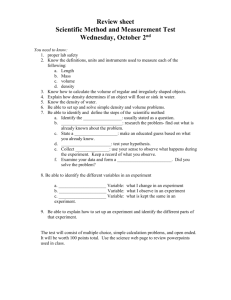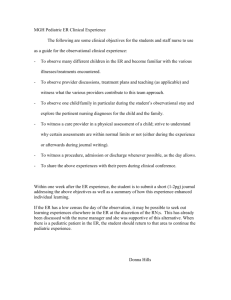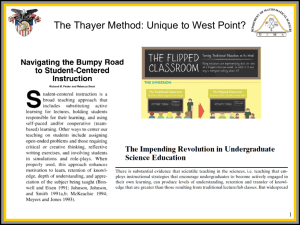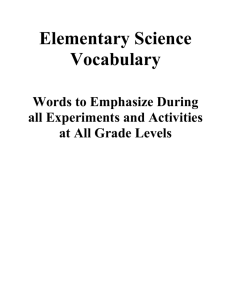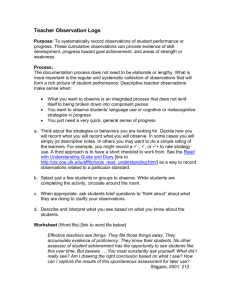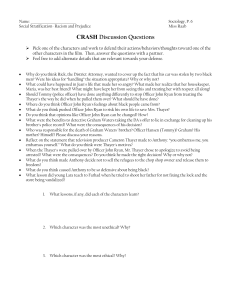Revision
advertisement
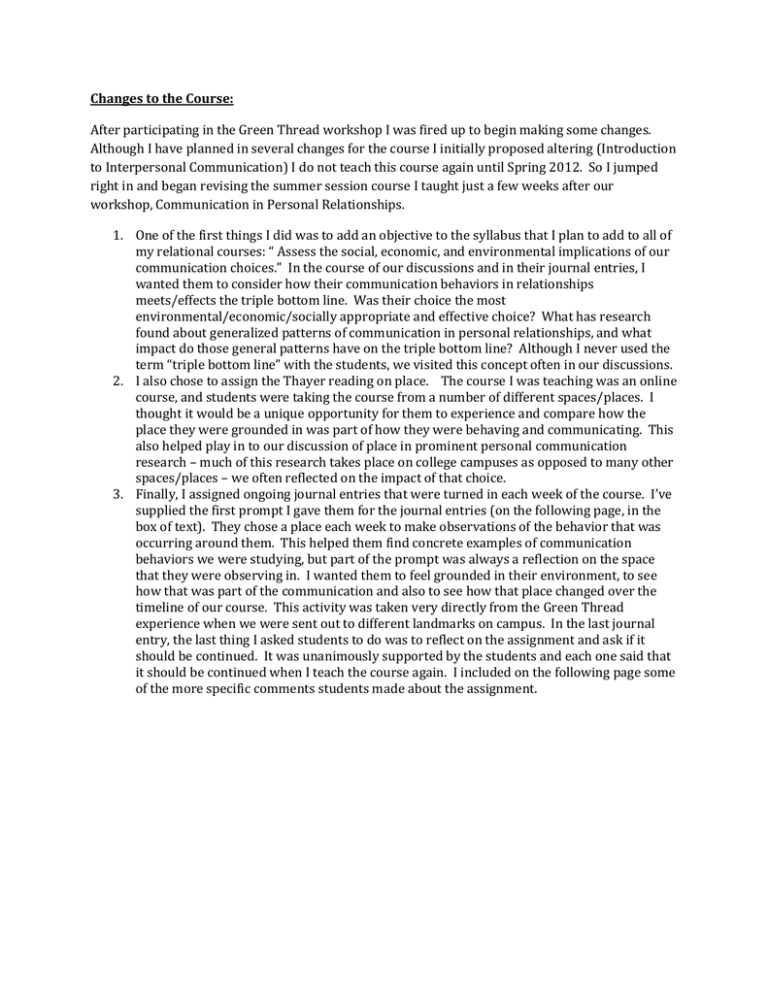
Changes to the Course: After participating in the Green Thread workshop I was fired up to begin making some changes. Although I have planned in several changes for the course I initially proposed altering (Introduction to Interpersonal Communication) I do not teach this course again until Spring 2012. So I jumped right in and began revising the summer session course I taught just a few weeks after our workshop, Communication in Personal Relationships. 1. One of the first things I did was to add an objective to the syllabus that I plan to add to all of my relational courses: “ Assess the social, economic, and environmental implications of our communication choices.” In the course of our discussions and in their journal entries, I wanted them to consider how their communication behaviors in relationships meets/effects the triple bottom line. Was their choice the most environmental/economic/socially appropriate and effective choice? What has research found about generalized patterns of communication in personal relationships, and what impact do those general patterns have on the triple bottom line? Although I never used the term “triple bottom line” with the students, we visited this concept often in our discussions. 2. I also chose to assign the Thayer reading on place. The course I was teaching was an online course, and students were taking the course from a number of different spaces/places. I thought it would be a unique opportunity for them to experience and compare how the place they were grounded in was part of how they were behaving and communicating. This also helped play in to our discussion of place in prominent personal communication research – much of this research takes place on college campuses as opposed to many other spaces/places – we often reflected on the impact of that choice. 3. Finally, I assigned ongoing journal entries that were turned in each week of the course. I’ve supplied the first prompt I gave them for the journal entries (on the following page, in the box of text). They chose a place each week to make observations of the behavior that was occurring around them. This helped them find concrete examples of communication behaviors we were studying, but part of the prompt was always a reflection on the space that they were observing in. I wanted them to feel grounded in their environment, to see how that was part of the communication and also to see how that place changed over the timeline of our course. This activity was taken very directly from the Green Thread experience when we were sent out to different landmarks on campus. In the last journal entry, the last thing I asked students to do was to reflect on the assignment and ask if it should be continued. It was unanimously supported by the students and each one said that it should be continued when I teach the course again. I included on the following page some of the more specific comments students made about the assignment. Assignment: Throughout this course you will be keeping an online journal. It will be graded, and to receive all of the points you must keep the journal focused mainly on our course concepts and ideas, as you witness them. In addition to simply showing me that you witness our course concepts and theories in action, however, I want to see what you are also learning from the place in which you're grounding this course. It is up to you to choose a public place where people regularly interact, and to spend time in that place several times a week. This might be a park, a mall, an airport, a campsite, a trail, etc. I will give you guidelines each time one of these journal entries is assigned as to what I want you to write about specifically. For this week: -pick a public spot where people regularly gather, and describe the spot to me. Where are you, geographically (state/city)? What is this place like in terms of physical atmosphere (inside/outside/warm/cold/etc.)? Finally, what is the social atmosphere like (are people friendly/unfriendly/conversational/quiet/etc.)? -Introduce yourself to me. Why did you choose this spot? What does it tell me about you? Journal entries will typically be about one double-spaced page in length. This entry may be a bit shorter, but should still be at least two good-sized paragraphs. In future weeks, you will be writing both about place and about how you observe our course concepts in the place/space you’ve selected. Student Responses: At first I didn’t really understand why the Thayer reading on bioregionalism was assigned for this class, but it does make sense after doing the observations and journal entries and becoming more accustomed to applying topics from the readings to what we observed in our immediate environments. I think that the Thayer article helped to relate the contents of this course to the broader philosophical, environmental and sociological issues in the world as well as add to the overall depth of the class. In general, I enjoyed the class, and I have really appreciated your positive feedback. (As sort of an interesting side note, the timing and content of this course has been rather ironic for me – my first serious boyfriend left to spend the summer in one of the most remote places on Earth up in Alaska, and the only means of communication we’ve had is via hand-written letters that take at least a week in-transit. Talk about asynchronous.) Reflecting on all my journal entries, I realized that environment plays a huge role in the way people communicate. For instance, couples come into Victoria's Secret because it is known for being a place where couples can openly purchase lingerie. There are certain times and places for certain behaviors and communication. It would not be likely to see a couple yelling and screaming in a public mall. Although it was difficult to observe most concepts covering in this class in a public setting, I would suggest assigning this activity again. I liked Thayer’s ideas about bioregionalism and agree with his argument that “where one is is also to know who one is and to understand what needs to be done. (Thayer, pg. 1). I hadn’t thought about this idea before and now realize how important where you is since it can define who you are and what you are doing there. In regards to this assignment I first have to say it did challenge me. It really made me look at the way people interact with each other on a deeper level. I would definitely suggest that you assign this type of assignment again because I feel like I have a better understanding of the concepts presented by being able to watch them in real life instead of just reading about them in a book. Overall, my perceptions have changed over the course of this class. I have always considered myself a ‘people-watcher,’ though in the past, I had never intentionally looked for specific communicative aspects. The ways in which I observe relationships have shifted, too. With the help of this class, I can observe relationships and understand more of what they mean. I feel like I have grown in small amounts over the last five weeks. It has been enriching to understand the concepts enough to not only observe other people, but also to observe myself. I think I have a better idea of how I communicate with other people, and plan to use this information to better the relationships I have with people. I think Thayer made a good point about the usefulness of bioregionalism. While certain topics are certainly more difficult to observe in certain environments than others, a place can have a large effect on the relationships inside of it. I personally found it enlightening to observe people in the same location each week and note what was different and/or what was the same. Though most of the customers change from day to day, the interactions which happen in an environment are similar. City Brew is a relationship-based business, and supports the idea of bioregionalism. I would definitely suggest that this activity be used in future classes. It is informative and fascinating. It is easier for visual learners to understand the terms from class if they are able to witness them firsthand. It was a fun way to interact with the material from class and apply it to life. I think that Thayer’s idea of bioregionalism is interesting because starting from the very soil of an area and learning the region that you live in from the geographic markers to the cultural markers is very interesting and important. I think this because just because I grew up in Montana on a farm and graduated with a class of 36 people, doesn’t mean that I am “small town girl” and will display “backwoods or hickish” behaviors as some of the culture that I grew up in, but just because someone is from a big city and had completely different attitudes doesn’t mean we wouldn’t be able to get along or have similar points of view. It is as you were saying in response to my first journal entry, I picked an interesting place but there may be different behaviors and situations to observe had I picked a bar or theater or something. You can really only observe what is in your bioregion, and then you can more out and start experiencing more bioregions. I think that this is an excellent way to incorporate the readings and terminology into the class. It is not difficult and even kind of fun. I would recommend that you do this experiment in future classes, just because it breaks up the readings in fun ways, allows you to interpret it and report it the way you understand it, and then it also in the end, helps you better remember the terminology and readings to benefit you in the future assignments. There are many parts of the Thayer reading that I enjoyed and agree with. I agree that we can all learn and grow from our surroundings. I was able to take a different approach to how I saw the world when I knew to look. Typically I would just go to the Central to eat and go. I would never really look and examine who and what was around me. Everywhere I go now I take a closer look and take in the scene. Bioregion or life-place is and idea I agree with. I feel we can all learn from what is around us. There is so much that gets over looked day after day that if we all took the time to really observe and understand our surroundings we can learn so much about ourselves and the world we live in. I like the idea of asking he three questions: where one is, who one is, and what needs to be done. Putting the whole situation on a checklist. I very much enjoyed this assignment and feel it should be assigned for future classes. It really opened my eyes to my surroundings. I have to say that I agree with Thayer’s idea on bioregionalism and learning about your environment. I will not be able to look at the swimming pool as just a place to take my child to get out of the house for a few hours during the week. The interactions taking place make the swimming pool a very social place where the dynamics are constantly changing. The group of girls that I observed are only on one small corner of the large swimming complex. It makes me wonder what other significant interactions are going on around the “watering hole”. I will be looking and watching through new eyes after this experience. I would absolutely recommend that you continue these types of assignment, as it is very hands on instead of memorizing what something is and answering a, b, or c. You actually see the concepts come alive and I will be able to remember the terms and ideas a lot better because of the way we incorporated it in this class. I have thoroughly enjoyed this course and the idea that you put in place about attending a spot of your choice and witnessing interaction. I think it is a wonderful way to put the concepts we have read about into actions and witness them first hand. It makes learning about them much more enjoyable and it validates their authenticity. It also brings an element to the course that makes things a lot more fun and interesting. Reading is one thing, but getting out and searching for what you have read about incorporates a level of interaction into the regime and "mixes things up." I definitely enjoyed taking part in it and in some ways saw it as a challenge. I really wanted to see how many of the concepts that we discussed I could witness. Sometimes I would even witness communication and behavior that would not necessarily be discussed in detail in the book, but contributed to my understanding of the topics that were discussed and in the end allowed me to form a greater understanding for what I had sought out to discover. I loved Thayer's piece that we read during week one. I think he was right on in that the environment is the best place to learn. This course is a prime example of that and how useful the environment can be. As I stated above, in addition to witnessing the concepts we discussed in class, I also witnessed several other communication behaviors that further broadened my knowledge and understanding of the subject. Had we not had to get out and survey our environment I would have not been able to do so, and thus would not have come out of this course with all that I have. I would definitely recommend you implementing this into your future courses, as I really enjoyed it and found it to be an exceptionally effective way of learning. Thank you for a wonderful five weeks, it has been a pleasure!

